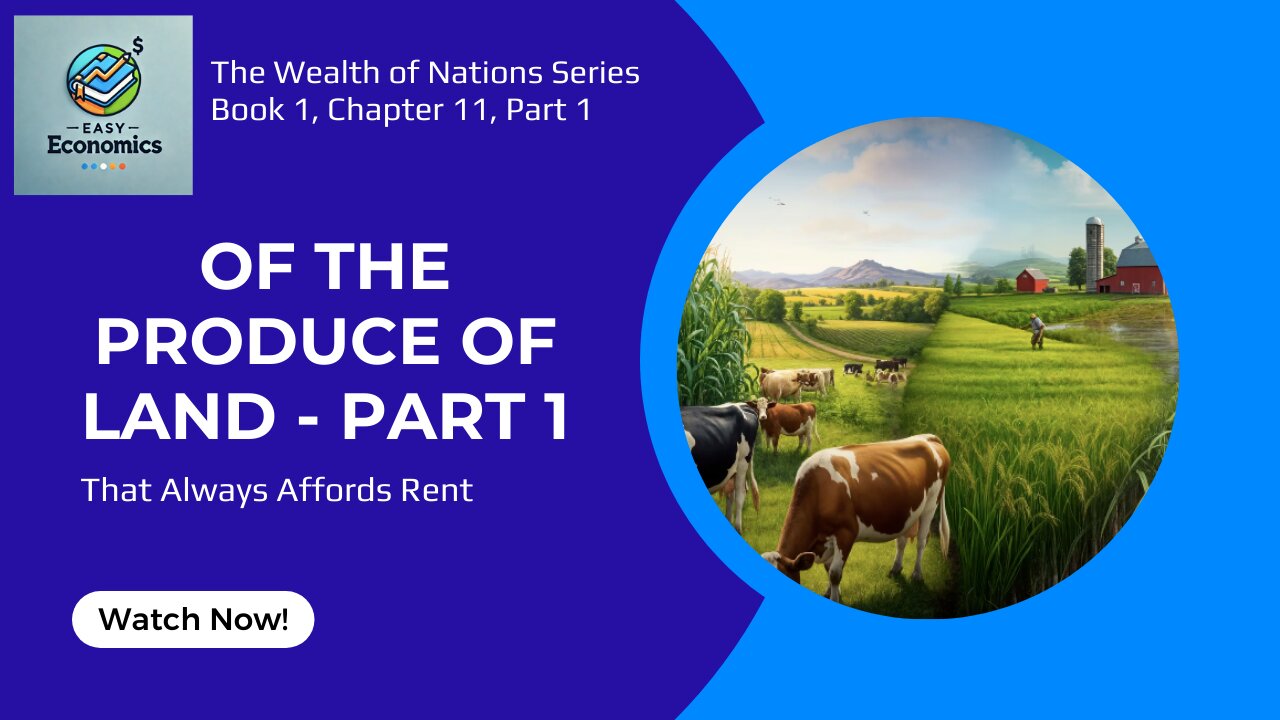Premium Only Content

The Wealth of Nations Book 1 Chapter 11 Part 1 - Of the Rent of Land
Are you interested to read the original book? Get ‘The Wealth of Nations’ by Adam Smith now: https://amzn.to/4gtY9ys
In this video, we explore the principles behind the rent of land, focusing on how landlords determine rent based on a tenant's ability to pay and the land's productivity. We delve into the relationship between land rent, crop profitability, and infrastructure like roads and canals, which can significantly influence rent by lowering transportation costs. Examples include high-rent crops like sugar plantations in the West Indies and vineyards producing premium wines.
We also examine how staple foods, like corn or rice, set the standard for rent in Europe, while more productive crops, like potatoes or rice, could increase rents by supporting larger populations. Rent reflects more than just investment; it often represents monopoly pricing, where landlords profit from natural advantages or tenant improvements.
Learn how land location, crop type, and market demand shape rent, as we unpack historical and modern implications for farming, trade, and economic development.
00:00 - The Rent of Land - Part 1
00:11 - Understanding Rent
00:48 - Landlord’s Investment and Monopoly Pricing
01:37 - Rent and Produce Prices
02:45 - Location and Infrastructure Impact on Rent
03:32 - Grain vs. Pasture Land
05:00 - Historical Perspectives on Agriculture
06:31 - Specialized Crops and Their Impact on Rent
07:42 - High-Value Crops and Land Rent
09:02 - Global Examples of Crop Profitability
10:07 - Standardization of Land Rent
10:54 - Alternative Staple Crops and Their Potential
11:52 - Conclusion
-
 1:21:03
1:21:03
Russell Brand
5 hours agoBREAK BREAD EP. 13 - WESLEY HUFF
121K6 -
 DVR
DVR
Game On!
2 hours agoRoger Goodell is FURIOUS at NFL fans who think Mahomes gets special treatment!
5.89K3 -
 10:31
10:31
Melonie Mac
3 hours agoMy Fantastic Four Movie Trailer Impressions
4.62K8 -
 2:08:22
2:08:22
The Quartering
6 hours ago20,000 Feds QUIT, DOGE Workers Lives At Risk, Trump Vs Dept Of Education, Brie Larson Based & More
95.1K72 -
 1:23:15
1:23:15
vivafrei
20 hours agoLive with Enrique Tarrio! Jan. 6 Lawfare ON STEROIDS! Proud Boys & Beyond!
97.7K39 -
 1:15:01
1:15:01
Savanah Hernandez
3 hours agoEl Salvador offers to take in U.S. prisoners while Elon’s autists take on the deep state
14.6K7 -
 7:12
7:12
Tactical Advisor
6 hours agoBudget 2011 That Uses Glock Mags?! | Fusion Firearms 2025
15.2K1 -
 58:19
58:19
Ben Shapiro
6 hours agoEp. 2131 - Trump and Musk Bring The CHAINSAW
93.8K69 -
 1:12:31
1:12:31
Russell Brand
7 hours agoTrump’s Trade Wars: Power Plays and Global Repercussions – SF531
111K38 -
 29:57
29:57
The Finance Hub
4 hours ago $5.37 earnedBREAKING: DONALD TRUMP JR. JUST DROPPED A MAJOR BOMBSHELL!!!
33.1K21